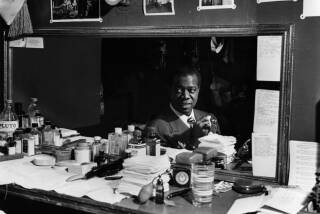Art Farmer: Eloquent Jazz Master of the Trumpet and Fluegelhorn
- Share via
Art Farmer, an eloquent jazz musician who was a master of the fluegelhorn, the trumpet and an instrument of his own creation called the “Flumpet,” has died.
Farmer, who lived in New York and Vienna after starting his decades-long career in Los Angeles, died Monday in Manhattan of a heart attack. He was 71.
Farmer’s playing was characterized by a sweetly lyrical tone and a melodic approach to phrasing, neither of which minimized his capacity to produce rhythmically swinging phrases. Versatile from the beginning, he moved easily from big band playing with Lionel Hampton to small group work with everyone from Horace Silver to Art Blakey. But his stylistic range was wide enough in the 1950s to allow him to perform effectively in such offbeat--and little-noticed--recording projects as John Benson Brooks’ edgy “Alabama Concerto” with Julian “Cannonball” Adderly, as well as recordings with the adventurous composer George Russell.
His collaboration with noted saxophonist Benny Golson in the Jazztet in 1959, produced some of the classic music of the bop era, music that managed to be entertaining and musically adventurous. The Farmer-Golson partnership resulted in the 1960 album “Meet the Jazztet” (MCA), which introduced such now classic tunes (written by Golson) as “Killer Joe,” “I Remember Clifford” and “Blues March.”
Farmer’s later, stylistically different relationship with guitarist Jim Hall was not effectively recorded, although “Live at the Half Note” (Atlantic) is a good representation of the group.
In his later years, when Farmer--like other prime players of his generation--was generally obliged to travel as a soloist, working with local rhythm sections, he continued to make efforts to expand his musical horizons.
In a performance at the Jazz Bakery four years ago, Farmer’s eloquent style was on full display. But at the age of 67, his style was continuing to evolve. As lyrical as ever and still blessed with a warm and supple sound, he also delivered several solos in which his characteristically flowing lines were interrupted by sudden, wide melodic leaps and disjunct rhythmic accents--unexpected shifts of style reflecting his desire to keep his musical imagination alive.
He extended that desire into his choice of instruments. Starting out as a trumpeter, he turned in the early 1960s to the darkly mellow sounds of the fluegelhorn, using it with considerable regularity. In 1989, he was instrumental in the creation of the Flumpet, a kind of hybrid combination of fluegelhorn and trumpet, created for Farmer by Portland, Ore., instrument maker David Monette.
Born in Council Bluffs, Iowa, Farmer was the older of fraternal twins. His brother, Addison, a jazz bassist, was born an hour later and died of a cerebral aneurysm 36 years ago.
Farmer’s parents were divorced when he was 4 and his father died in a steel mill accident a short time later. His mother moved to Phoenix with the children, which also included younger sister Mauvolene.
Music was Farmer’s passion at an early age. He played piano in elementary school, then switched to violin and tuba. At 13 he discovered the coronet and played in the school band.
In 1945, when Farmer and his brother were 16, they came to Los Angeles on a summer break and, after witnessing the burgeoning jazz scene on Central Avenue, decided to stay. Their mother remained in Phoenix but elicited a promise from them that they would finish high school, so they enrolled at Jefferson High.
Because many jazz musicians were still in the armed forces in 1945, the Farmer brothers, despite their youth, found work fairly regularly. Art Farmer played with bands led by Benny Carter, Gerald Wilson and Lionel Hampton.
Wilson recalled Farmer on Wednesday as “a marvelous trumpet player.”
“He had fine range, good execution, a good concept of playing. Nothing was too difficult for him; the changes weren’t too hard for him, no matter what kind of number it was.”
In 1952, Farmer left Los Angeles to tour with Hampton. He left the tour in New York City and settled there working with Charles Mingus, Silver and Gerry Mulligan.
He was an original member of Silver’s first quintet, appearing on the late 1950s recordings “The Stylings of Silver” and “Further Explorations” (both on Blue Note.) Silver recalled Farmer as a man who “always had his own sound and his own style.”
“He knew his chord changes, he could improvise very, very well, and he was a sweet, mild-mannered guy to work with,” Silver added. “I always find nicknames for the guys in my band, and I used to call him ‘Arturo ToscaFarmer.’ ”
In the late 1960s, when rock music was starting to take hold in America, Farmer moved to Vienna, where he joined the state-subsidized Austrian Radio Orchestra.
He once told an interviewer that when he was home in Vienna he would practice four or five hours a day in a special soundproof room.
“I start with intervals and scales,” he told the New Yorker, “Then I play songs, sometimes by myself, sometimes with tapes. I warm up for an hour before a gig. Your horn has to be warmed up, your body has to be warmed up, you lips have to be vibrating a certain way. If the horn has that proper singing sound, it leads to good things, to good improvisation. It opens your mind to creativity.”
Heckman is the Times jazz writer and Thurber is a Times staff writer.
More to Read
The biggest entertainment stories
Get our big stories about Hollywood, film, television, music, arts, culture and more right in your inbox as soon as they publish.
You may occasionally receive promotional content from the Los Angeles Times.










